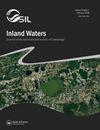气候变化和富营养化之间的反馈:重新审视联合攻击概念以及如何反击
IF 2.3
3区 环境科学与生态学
Q1 LIMNOLOGY
引用次数: 28
摘要
尽管富营养化对社会和生物多样性有着广泛的负面影响,但它仍然是淡水到海洋连续体中最普遍的人为影响之一。富营养化与气候变化,特别是气候变暖之间的相互作用,在十年前由布莱恩·莫斯(Brian Moss)等人在《联合攻击:气候变化和富营养化》(Allied attack: climate change and富营养化)一书中明确提出,考虑到这两个问题明显的协同作用,他们呼吁对这两个问题采取综合对策。在本文中,我们总结了这一问题的理论框架和实证研究的进展,并分析了目前对气候变化增强富营养化的主要驱动因素和机制的理解,以及气候变化增强富营养化的主要驱动因素和机制,并特别关注浅湖。气候变化可以通过影响水文模式和火灾频率以及温度对养分循环的影响,从而影响流域和景观水平的变化,从而影响养分负荷。生物群落及其相互作用也可直接或间接地受到气候变化的影响,导致对富营养化影响的复原力总体减弱。现在越来越多的经验证据表明,富营养化水生系统可以通过几种机制日益成为大气中温室气体,特别是甲烷的重要来源。我们还强调潜在的反馈之间的富营养化,蓝藻华,和气候变化。同时面对这两项挑战比以往任何时候都更加紧迫。因此,如果我们要确保生态系统的恢复力和安全的供水,保护生物多样性,减少淡水的碳足迹,就需要在景观和水体层面采取有意义和强有力的措施。本文章由计算机程序翻译,如有差异,请以英文原文为准。
Feedback between climate change and eutrophication: revisiting the allied attack concept and how to strike back
ABSTRACT Despite its well-established negative impacts on society and biodiversity, eutrophication continues to be one of the most pervasive anthropogenic influences along the freshwater to marine continuum. The interaction between eutrophication and climate change, particularly climate warming, was explicitly focused upon a decade ago by Brian Moss and others in “Allied attack: climate change and eutrophication,” which called for an integrated response to both problems, given their apparent synergy. In this review, we summarise advances in the theoretical framework and empirical research on this issue and analyse the current understanding of the major drivers and mechanisms by which climate change can enhance eutrophication, and vice versa, with a particular focus on shallow lakes. Climate change can affect nutrient loading through changes at the catchment and landscape levels by affecting hydrological patterns and fire frequency and through temperature effects on nutrient cycling. Biotic communities and their interactions can also be directly and indirectly affected by climate change, leading to an overall weakening of resilience to eutrophication impacts. Increasing empirical evidence now indicates several mechanisms by which eutrophying aquatic systems can increasingly act as important sources of greenhouse gases to the atmosphere, particularly methane. We also highlight potential feedback among eutrophication, cyanobacterial blooms, and climate change. Facing both challenges simultaneously is more pressing than ever. Meaningful and strong measures at the landscape and waterbody levels are therefore required if we are to ensure ecosystem resilience and safe water supply, conserve biodiversity, and decrease the carbon footprint of freshwaters.
求助全文
通过发布文献求助,成功后即可免费获取论文全文。
去求助
来源期刊

Inland Waters
LIMNOLOGY-MARINE & FRESHWATER BIOLOGY
CiteScore
6.10
自引率
9.70%
发文量
34
审稿时长
>12 weeks
期刊介绍:
Inland Waters is the peer-reviewed, scholarly outlet for original papers that advance science within the framework of the International Society of Limnology (SIL). The journal promotes understanding of inland aquatic ecosystems and their management. Subject matter parallels the content of SIL Congresses, and submissions based on presentations are encouraged.
All aspects of physical, chemical, and biological limnology are appropriate, as are papers on applied and regional limnology. The journal also aims to publish articles resulting from plenary lectures presented at SIL Congresses and occasional synthesis articles, as well as issues dedicated to a particular theme, specific water body, or aquatic ecosystem in a geographical area. Publication in the journal is not restricted to SIL members.
 求助内容:
求助内容: 应助结果提醒方式:
应助结果提醒方式:


